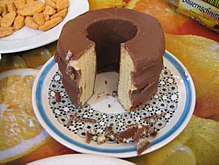cake

The cake is one of the fine baked goods . It is mostly a sweet pastry. One differentiates between sheet cakes and cakes that are baked in a baking pan according to the type of production . In contrast to a cake , a topping or filling is not added after baking, but baked with it. In colloquial terms, this difference is not always strictly adhered to, so certain cakes are also referred to as pies (e.g. quark cake , Bündner nut cake , Linzer cake ). Some of the cake is glazed after baking . Savory cakes include onion tarts , tarte flambée , bacon cakes and quiche .
General
The batter is depending on the recipe from flour , sugar , binder (eg. B. egg ) and fat ( butter or margarine ), a liquid ( milk , water or juice ), flavors (eg. B. Backaroma ) and a leavening agent ( baking soda or yeast ) that are mixed together. Important types of dough are yeast dough , shortcrust pastry (kneading dough) and batter .
Bakeries and pastry shops offer cakes in pieces or as baking tray units. In supermarkets there are cakes made by large bakeries.
Cake baking is traditionally widespread, especially in Europe and North America, while it only plays a subordinate role on other continents; in Asia rice cakes are almost exclusively known. In China , the moon cakes also have a special meaning.
In Europe, cake is traditionally consumed in the afternoon with coffee and cake or with Sunday coffee . Often cakes are baked for birthday parties or special occasions.
Various dishes or baked goods that carry the cake term in the name, such as pancakes ( eggs ), and the donuts as Boiling pastry , sour cream cake or regionally strawberry cake called strawberry pie , not part of the cake. The cold dog or cellar cake , which is not actually baked but is usually served as a “cake”, is therefore a dessert or sweet , similar to tiramisu .
history
In ancient Greece , plakous was the word for cake and had the same stem as the word for flat (related to flatbread ). In Latin it became placenta , which today is the term for mother cake in a modified and transferred meaning , and in German cookies . In the second century BC Cato described a cake that resembled modern cheesecake . The Romans used yeast for baking in ancient times. In the Middle Ages , the most common cake was a type of sweet bread or fruit bread . Fine pastries only emerged with the spread of fine sugar in the 16th century; During this time the sponge cake was introduced . By the 17th century at the latest, early springform pan models were used for baking. In the 19th century came baking soda and baking powder on the market. New ingredients such as chocolate or cocoa and vanilla were not used for cakes and tarts until the 18th century.
Well-known cakes
Web links
Individual evidence
- ↑ Annemarie Wurmbach: Cake - Fladen - Torte: A verbal and expert investigation. In: Zeitschrift für Volkskunde , Volume 56, 1960, pp. 20–40.
- ^ Alan Eaton Davidson : Cake . In: Ders .: The Oxford Companion to Food . 2nd edition OUP, Oxford 2006, ISBN 978-0-19-967733-7 , (EA Oxford 1999).

